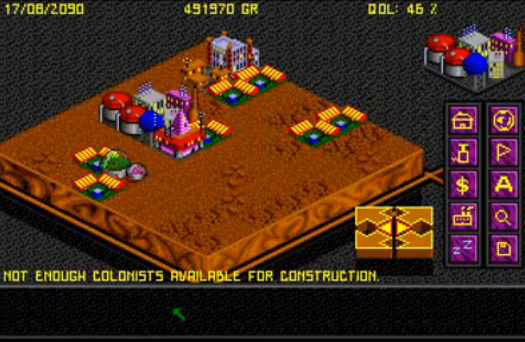
[screenshot from Utopia, a rather unique game that blended SimCity-esque urban development with a proto-Starcraft model of realtime combat management in a science fiction setting]
Getting quite close to the (October 9th) release date for Cities XL, which is at least moderately interesting to those of us (I’d imagine a fair percentage of designers in their twenties and thirties) who developed and/or nurtured childhood fascinations with urban planning through SimCity and the like. What should be the final trailer can be found here. It seems there’s a bit of controversy because the basic release’s transportation options will be limited to roads and freeways, which I suppose I would find disappointing (if I planned on playing the game, which I don’t think I do) as, even though there’s nothing wrong with the vicarious thrill of watching citizens stuck in hellish traffic in the pollution-choked metropolis you’ve built, we play these sorts of games to experiment, and so having to pay extra for the buses and trains is a bit like having to rent the shovel for the sandbox.
The real disappointment, though, is how strictly limiting these games can be — in SimCity, for instance, the entire game engine was built around modeling cause and effect in the urban system as understood by the late 20th century modernist planning orthodoxy, in which the ultimate planner is a near-deity, laying out strictly-defined, single use zones within his city, with the primary feedback loop being the construction, abandonment, and demolition of buildings based upon increasing or decreasing real estate values. It’d be much more thrilling to enter into (and, I admit, much more difficult to build) a gameworld where the player encounters more basic conditions (populations, ecologies, resources, terrain) and, in the process of responding to those conditions, constructs the urban ruleset as a by-product of interaction with the gameworld. So one player might be drawn to orderly boulevards organized around pedestrian transportation and discover himself a virtual Baron Haussman, or another organizes his city around vast parks, over and underpasses, and sky-lit skyscrapers, unwittingly resurrecting Le Corbusian planning, only to find his city devolving into a Blade Runner-esque dystopia1.
Or, even better, instead of Cities XL, its Infrastructure XL, and rather than semi-omnipotent mayor, you’re the superintendent of public works: you build tangled on-ramps, dig vast subterranean networks for trains, massive piers for transoceanic commerce to dock at, dams, powerlines, sewers, solar farms, canals, parking garages, airports, public parks, playgrounds, landfills, cemeteries, wastewater treatment plants, reservoirs, nuclear power plants, stormwater detention ponds, and so on — all for the pleasure of watching the city shift, grow, and evolve in response to them. Who’s to say that a more limited and focused decision set wouldn’t present more interesting choices? Build the egg digesters and they will come. Now that’s a game I’d play.


[…] urban social systems, and insurgent violence. It’s not exactly what I was thinking of when I described a hypothetical Infrastructure XL, but UrbanSim (that’s the actual title of the game) […]
[…] by the gamer and the fetishization of control in modernist urbanism — is a topic which we have occasionally discussed.] This entry was written by rholmes, posted on July 7, 2010 at 8:00 pm, filed under […]
“Why, also, are the buildings built and terrains inhabited by the citizens of SimCity and Cities XL so dull? Where’s the game that lets us manage Underground Berlins, New Babylons, or Cable Cities? You know you’d play that.”
This is a good question. One of the things I find so strange about procedural design is that coders go to great lengths to develop a system for making completely unremarkable cities. I understand the desire within animation and film to have an “auto-backdrop” but it is kind of ironic to use new tools to clone stamp generic urbanism ad infinitum.
[…] Video games are potent ‘viewing machines‘ when it comes to urban experience, their abstract bounds often coinciding with real-life problems and constraints. In this one, players on PC can navigate a […]
[…] mammoth’s professed interest in finding overlap between gameworlds and cities, it’s probably not surprising that this leads me to wonder: what other games might […]